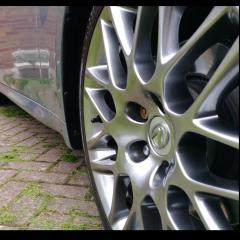Leaderboard
-
in Tutorials
- All areas
- Articles
- Article Comments
- Article Reviews
- Discounts
- Discount Comments
- Discount Reviews
- Videos
- Video Comments
- Video Reviews
- Articles
- Article Comments
- Article Reviews
- Tutorials
- Tutorial Comments
- Tutorials Reviews
- Images
- Image Comments
- Image Reviews
- Albums
- Album Comments
- Album Reviews
- Events
- Event Comments
- Event Reviews
- Topics
- Posts
- Status Updates
- Status Replies
-
Custom Date
-
All time
February 28 2013 - April 29 2024
-
Year
April 29 2023 - April 29 2024
-
Month
March 29 2024 - April 29 2024
-
Week
April 22 2024 - April 29 2024
-
Today
April 29 2024
-
Custom Date
06/24/2018
-
All time
Popular Content
Showing content with the highest reputation since 06/24/2018 in Tutorials
-
If your like me, the best part about owning a Lexus is the nice toys and technology that Lexus offer. I've recently swapped my IS220D SE-L for a IS250 SE, The SE-L was fitted with the illuminated door sills that light up "Lexus" when you open the doors, a really nice feature which should be standard in my opinion. Unfortunately my 250 SE only had the basic plastic sills that look a bit cheap on a Luxury car so i pulled off the plastic ones to find that the cars are fitted as standard with the plug for the illuminated sills, so I thought I could just buy the illuminated sills and plug them in. Unfortunately it turned out that this is not the case, all the cars do indeed have the plug however the plug is only wired in on the Luxury and sports spec models, to get around this problem you need to do some basic home wiring which I will show you now. Please note: I take no responsibility for any damage done to your vehicle while following this guide. For this modification you will need the following: 1-2M of Auto Wire 4x Scotch Locks A Pair of Bull Nose Pliers A Pair of Snips Stanley Knife/Craft knife Step 1: Remove the existing door sills to reveal the wiring loom underneath ( A bit of brute force pulling straight up will remove the sills) Step 2: Using a Stanley Knife or Craft knife, carefully cut away the electrical tape that covers the wires that go into the door sill connector (Be particularly careful not to cut into any wires in the loom). Step 3: Take your Auto Wire and 1 scotch lock and Scotch lock your auto wire and the White wire going into the Door Sill Connector together (Leave the blue wire as it is). Step 4: Remove the interior trim that covers the seat belt tensioner system (to aid this process put the seat in the fully back position and the backrest all the way back, and open the rear door. Again some force will release the clips holding the panel on). Step 5: Locate the wire that connects to the Door switch, it sits on the inside of the pillar behind the switch. (A White Wire on the drivers side and Purple on the Passengers side, shown in the image above). Step 6: Trace your auto wire around the current loom to reach the Door Switch wire behind the seat belt panel. (when doing this ensure that your auto wire cannot rub on the seat belt as it moves back and forth during use). Step 7: Take a Scotch lock and scotch lock the Door Switch wire and auto wire together (Ensure you don't short out the wire on the vehicle's body work while using metal tools. I also wrapped some electrical tape around the scotch lock to ensure nothing metal would contact the bodywork in the future). Step 8: Plug in your illuminated door sills to ensure they are working correctly, when you push the Door switch the Sills should shut off and then light up when the switch is released. (If your Sills don't light up please check to see if you have your interior light switch set to come on when the doors open). Step 9: When you are happy that everything is working correctly, push the interior trim panels back into place. Some pressure on the areas should clip everything back in to place. Finished Product. I hope this guide was helpful, if i've missed anything or you have any questions please post here and I will endeavour to help the best I can.1 point
-
The workshop manual does not tell us how to do this job. I had to work it out for myself. Here is what is involved:- 1. Remove air intake, disconnect MAF sensor and remove the complete air box. This will give you room to work. 2. Undo the nuts securing the tensioner. You cannot remove the tensioner yet because the alternator is in the way. 3. Undo the nuts and bolt securing the alternator. You cannot remove the alternator yet because the power steering pump pulley is in the way. 4. Remove the power steering pump pulley. I had to wedge a chisel through one of the pulley holes to hold the pulley. It needed a long bar to undo the nut. The pulley wheel needed a lot of persuasion from behind with a screwdriver before it came free. 5. Move the alternator out of the way. 6. You cannot move the tensioner yet because the plastic cover (shown with a label in the second picture) prevents this. You cannot remove the plastic cover until you have removed the timing belt cover. 7. You can now breathe a sigh of relief and remove the tensioner. You may also ask yourself why you did not get your mechanic to do the job. 8. Reassembly is a reverse of what you have just done. Torque figures for the alternator fixings are 39 Nm and 43 Nm for the P/S pump pulley. 9. There may be an easier way, but I am not a trained mechanic. I just wanted others to benefit from my experience.1 point
-
I posted this a while back but I forgot to post in this section. I've added a few photos at the bottom as well. First off, I am not a mechanic so my terminology may annoy some of you! I did this as i was getting a lack of power at about 2500revs mainly in higher gears. It has improved dramatically. Fuel efficiency seems to have improved but only slightly so I can't say for sure. For this guide, I refer to right and left as you stand at the front of the vehicle looking into the engine. I know this is not the norm so apologies if confusing. Front refers to the front of the car as standard. Also, the elec. connectors are the biggest pain in the &%$£. Trying to squeeze the clip and pull at the same time is so difficult as they are usually well stuck in place being nine years old! Don’t give up! Job time – 10 hours over two days (I didn’t have a guide so hopefully you will do it faster – it would take me about 6 hours if I did it again) Set up tools, bench, laptop, etc. (1 hour) Disassembly (5 hours) Cleaning (2 hours) Reassembly (2 hours) Basic tools are required but just having a good socket set is very important. Not necessary to jack up vehicle but would help. I drove the front wheels up on 3inch blocks. This is the order I did it in, you may want to do it a little differently. I include headings for the most part but in general this order worked well. Here we go!... Covers: Remove primary engine cover Remove RH engine cover Remove LH engine cover Remove front engine cover Remove under engine covers (x2) Battery: Disconnect battery terminals Remove battery horizontal support brace Disconnect the electrical connection on the LH side of the battery cover Remove battery cover Remove battery Remove base cover of battery Remove battery vertical support brace Remove control module under battery (x3 bolts – long one goes on RH side) Disconnect 3 elec. connectors on control module Remove bottom battery case (x3 bolts) EGR: Remove EGR pipe and gaskets Disconnect EGR elec. connector Remove EGR valve Radiator: Open radiator cap and drain ***** (have bucket ready to take ~5 litres) Drain fluid Remove air intake duct above radiator Disconnect inlet and outlet pipes of radiator fluid reservoir tank Remove reservoir tank Various: Disconnect fuse box wire harness clips (x2) Disconnect common rail front end elec. connector Disconnect common rail fuel supply hose Disconnect common rail rear end elec. connector Remove wire harness support bolts (x2) Various: Disconnect EGR valve rear end elec. connector Remove five wire harness clips (red arrows) Remove harness support (green arrow) Remove sponge adjacent to EGR valve Various: Remove bolts (x3) on water pipe (blue arrow) below EGR assembly Remove clip at front end of pipe and slide hose off Remove vacuum hose (small) from water pipe (underneath) Remove elec. connector under vacuum hose & remove clip also (hard to see but you’ll know it has to be disconnected) Push hose assembly out of the way – towards battery area (no need to fully disconnect) Air Flow (Throttle) Assembly:- Disconnect three elec. connectors on air flow unit Remove bolt on air flow unit Common Rail:- Remove common rail bolt (x2) Remove common rail fuel lines Protect (tissue) the common rail connectors & ports Remove common rail and keep clean Inlet Manifold: Disconnect vacuum hose from inlet manifold Remove inlet manifold upper stay bolt (it’s a vertical support that can be hard to see) Remove air flow pipe to inlet manifold (1 clip also) (difficult to remove for me but keep twisting and pulling – there is a lip to overcome) Loosen inlet manifold lower stay nut (very difficult to access – hard to even see. This was the most awkward part of the whole job. You should really disconnect for easier access but it would be impossible to get it back on – loosening and pushing it aside was fine for me) See diagram below. Remove bolts (~x9) on intake manifold Remove intake manifold Cleaning: Clean inlet manifold – I used a power hose, carburettor cleaner, screwdriver for scraping & kitchen paper. Clean inlet ports – as above but I used a hoover continuously to prevent as much carbon as possible entering the valves/cylinders Reinstall in reverse – much easier than disassembly! Prime the fuel system. Photos: Photo 1 - Inlet ports exposed after inlet manifold clean. Of the four ports showing, the first has been cleaned mostly, the second is as found, and the third and fourth have some cleaning done. Highly recommend using a hoover if scraping any carbon from here. Otherwise just coat with carburetor cleaner and wipe away with a cloth. Photo 2 - Inlet manifold removed. Condition hard to see but constriction increases further into the ports. Photo 3 - Inlet ports - two untouched and two partially cleared.1 point
-
Copied here from the general forum ... Finally got around to looking at these.- the tilt function when reversing worked well when I bought the car but over time it has reduced to the point where it just twitched when moving into reverse. I planned to have a look at it months ago but just never got round to doing it. I done it today and took pictures of each step. It took half an hour for the first mirror and 20 minutes for the second so not a time consuming job. I needed to replace two worn plastic motor worm gear cogs which had partly stripped and I gave the mirrors a very good clean inside and out. Re-greased and oiled. They had accumulated a lot of dirt over the years and I don't think anyone had been in them since it rolled off the production line so it was a well worthwhile job. They are now working spot on and are holding their memory positions when starting the car. I could not get them to stop working after testing them for about 10 minutes so am happy and confident they are now fixed. I think the winter has a big effect on them when they are frozen up - they will automatically try to set themselves to the user position and also will try to move when reversing which puts a strain on the motors making them skip and strip teeth. Anyway - what I have done below worked for me - I have two good motor units left spare which I sourced which you can use the plastic work gear from or the units themselves if anyone does this and finds they need them. Pictures below are in sequence marked from picture 1 to 14. I have never managed to fit them into a post with instructions against them so the instruction is on the picture itself.1 point





